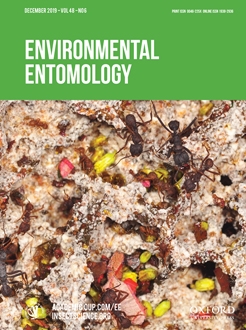Fopius arisanus (Sonan) (Hymenoptera: Braconidae) is a koinobiont solitary parasitoid of various fruit flies, particularly those in the genus Bactrocera. Researchers introduced F. arisanus into Africa for the biological control of Bactrocera dorsalis (Hendel) (Diptera: Tephritidae), a pest of a wide range of fruit trees and vegetables. However, the suitability of host fruit species as egg-laying substrates for parasitoid development remains poorly investigated in tropical Africa. The present study examines the preference and performance of F. arisanus on B. dorsalis reared on eleven fruit species through laboratory choice-test trials. We assessed the oviposition activity, parasitism rate, developmental time, and offspring fitness of F. arisanus on nine cultivated and two wild host fruits species. Oviposition attempts were higher on Psidium guajava (L.) (Myrtales: Myrtaceae) and Mangifera indica (L.) (Sapindales: Anacardiaceae) than on the other host fruits tested. The wasp parasitized host eggs in P. guajava in no-choice experiments. Psidium guajava, Irvingia wombulu (Vermoesen) (Malpighiales: Irvingiaceae), and Irvingia gabonensis (Aubry_Lecomte) Baill (Malpighiales: Irvingiaceae) were suitable for parasitism in choice tests. Of all host fruits tested, the body and hind tibia lengths of both parasitoid sexes emerging from M. indica were longer than on the others.The female ovipositor was long on Annona squamosa (L.) (Magnoliales: annonaceae) and short on Eribotrya japonica ([Thunb.] Lindl.; Rosales: Rosaceae). We obtained the longest preimaginal developmental time for both sexes on E. japonica and the shortest for females and males on Carica papaya (L.) (Brassicales: Caricaceae). These results demonstrate the ability of some tested fruit species to serve for the permanent establishment of F. arisanus in the field.
How to translate text using browser tools
5 October 2019
Fruit Preference, Parasitism, and Offspring Fitness of Fopius arisanus (Hymenoptera: Braconidae) Exposed to Bactrocera dorsalis' (Diptera: Tephritidae) Infested Fruit Species
S. Nanga Nanga,
R. Hanna,
D. Gnanvossou,
A. Fotso Kuate,
K. K. M. Fiaboe,
C. Djieto-Lordon
ACCESS THE FULL ARTICLE
It is not available for individual sale.
This article is only available to subscribers.
It is not available for individual sale.
It is not available for individual sale.

Environmental Entomology
Vol. 48 • No. 6
November 2019
Vol. 48 • No. 6
November 2019
biological control
diversity
fitness
parasitism rate
Tritrophic interaction




